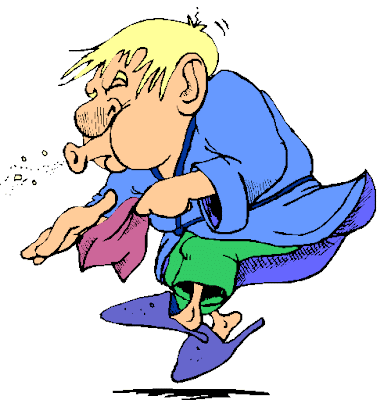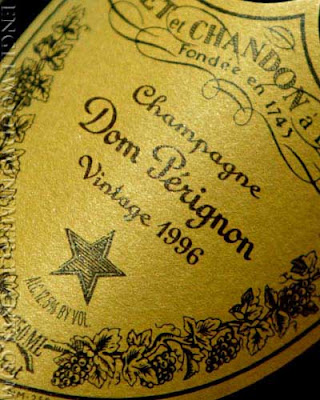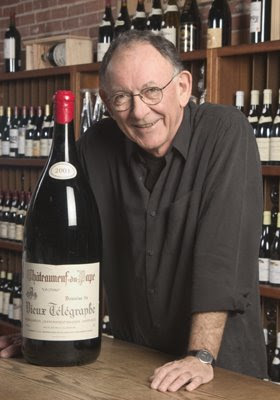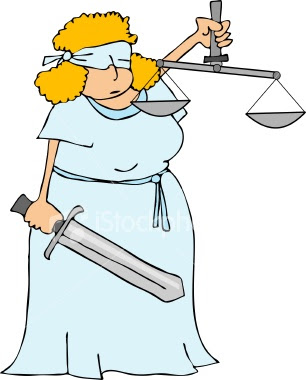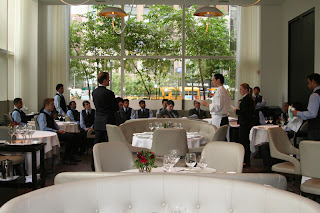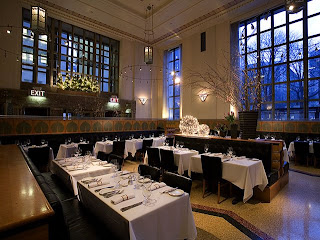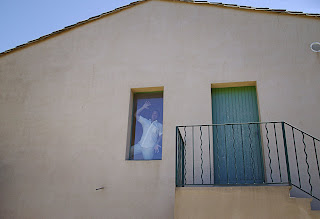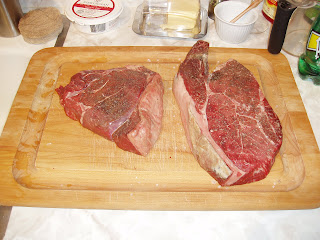 Grass-fed on the left, grain-fed on the right
Grass-fed on the left, grain-fed on the rightSaturday night I decided to do a mini-steak-off, comparing 28-day dry-aged grass-fed and similarly treated grain-fed boneless sirloins. So we invited my neighbor Asher and his lovely girlfriend Jodi over and we began popping and pouring while I started cooking. Or rather, popping and wrinkling our noses or brows in horror/confusion/consternation as bottle after bottle turned out poorly.
I had been told to pan-sear the grass-fed for 2 minutes on each side, then again for 2 minutes on each side, for black and blue (my preference). The grain was also cooked to black and blue in a stainless pan using a healthy mix of olive oil, butter and duck fat. Needless to say, the place got pretty smoky pretty fast...
That said, it was an interesting comparison.
The grass-fed was subtler and chewier than the grain-fed, which exhibited some powerful beef notes. The crust on the grass-fed was crunchier and darker, however, and while it was cooking I detected notes of grass in the smoke rising from the pan.
I liked both, so I can't say whether one is better than the other, they're just completely different beasts. I think it will depend on one's mood, really. Interestingly, the next day, the grass-fed had a better taste than the grain-fed (yes, we had leftovers, 4 lbs for 4 people is too much for us).
Now, for the wines... Well, at least the food was good. It's been a while since I had such an off night with wines, but this was quite the doozy. I think my quota for corked/cooked/dead wines for 2007 and 2008 has been met, and then some...
-2002 Carillon Puligny MontrachetA perennial favorite, this wine has always been lovely and generous with its flavors, showcasing not only the great vintage but the terroir and the winemaker's skills.
Sadly, this night, it succumbed to an assault of TCA (
cork taint) so powerful that I sensed it even before the cork had been fully removed. Not a good omen, this was the very first bottle opened this evening.
UGH.
-1992 Schoffit Rangen Clos St Theobold Aaaah, OK, redemption. Deep gold, with slight petrolly notes wrapped around green apples and minerals, a medium-bodied oily mouthfeel and with just a hint of sweetness on the attack finishing with sharp acidity. A bit short on the finish.
Quite nice with our foie gras appetizer.
With our first course of mushroom soup, I went for the reds.
-1976 Ampeau Volnay Santenots WTF? On the nose, it shyly admitted it was Burgundy, and on the palate, nothing. Nada. Zip. Zilch. Rien. Not corked, not cooked, just not there.
I swirled and swirled and swirled, and still nothing. This wine just refused to come out and play.
Grrrr....
-1999 La Gerla Brunello di Montalcino Riserva Opened the previous night, this offered cherry-covered mushrooms and went nicely with the soup. It was slightly subdued, but at this point I'd drink anything, I was getting frustrated.
-1997 Daniel Rion Nuits St Georges Vignes Rondes Ooooh, another attempt at redemption!
Cherries, cherries and more cherries, all wrapped in lovely stinky sous-bois on a ripe frame that was ever so slightly disjointed but still drinking easily. The finish was a bit short, but this went quite well with the soup as one can imagine.
Now that the steaks were done, we poured bigger reds.
-1974 Beaulieu Georges de Latour Reserve DOA. Damn.
I love older CA but this just didn't survive, sad to say. Tons of cedar, tea leaves, and not much else. No fruit whatsoever.
-1989 Guigal Cote Rotie Cotes Brune et Blonde Aaaah, big and beefy, with lovely dark fruits buttressed by a burly frame and rich, nutty accents. Soft yet powerful, like a fist in a velvet glove. This went great with the beef, but that's just a "duh" statement.
At this point I was getting annoyed with all the dead soldiers, so I ran to the cellar and pulled out two more reds.
-1976 Mouton Rothschild DOA. ARGH!
-2005 Jadot Bourgogne Rouge Who knew? Bright, crunchy red cherries with sparkling acidity greeted the palate, waking me back up after the brutality of the previous wines. For $15, not bad.
This was so comparatively good that we opened a 2nd bottle with similar notes.
As we chatted about our streak of bad luck, Asher helped me clear the table and I got the cheeses.
-1985 Speri Recioto della Valpolicella Amarone This wine offered big and dark fruity and nutty notes , with sharp VA and a hint of caramelization. Slowly but surely, it became apparent that this was too dark, and we all came to the realization that this bottle had been slightly heat-abused in the past.
Are you kidding me? Another bad bottle?
-2000 Ramonet Puligny Montrachet Champs Canets Opened before dinner, this had been tightly nailed shut, with some odd odors.
Now, I opened it, looking forward to that lovely minerally minty Ramonet smell. Instead, I was greeted with yet another bottle full of TCA, and, to boot, it was premox'd. Double whammy.
GOD DAMNIT!
Now, I was buzzing from anger as well as alcohol, so I raided the cellar, grabbing the first white I saw.
-2004 Girardin Puligny Montrachet les Perrieres Aaaaaah. I could relax now. Beautiful aromas of wet stones and almonds wrapped in a lacy gauze of lemons and lime, backed up with some quartzy minerals, with a slightly oily mouthfeel that just went on and on, ending with some spicy acidity.
Way too young, but who cares, this was just fantastic, especially with the Tomme de Savoie.
What a night, though it was made enjoyable by the friendly company and the delicious steaks. I really believe this means my quota of bad bottles for the remainder of the year has been met.
Cheers!

